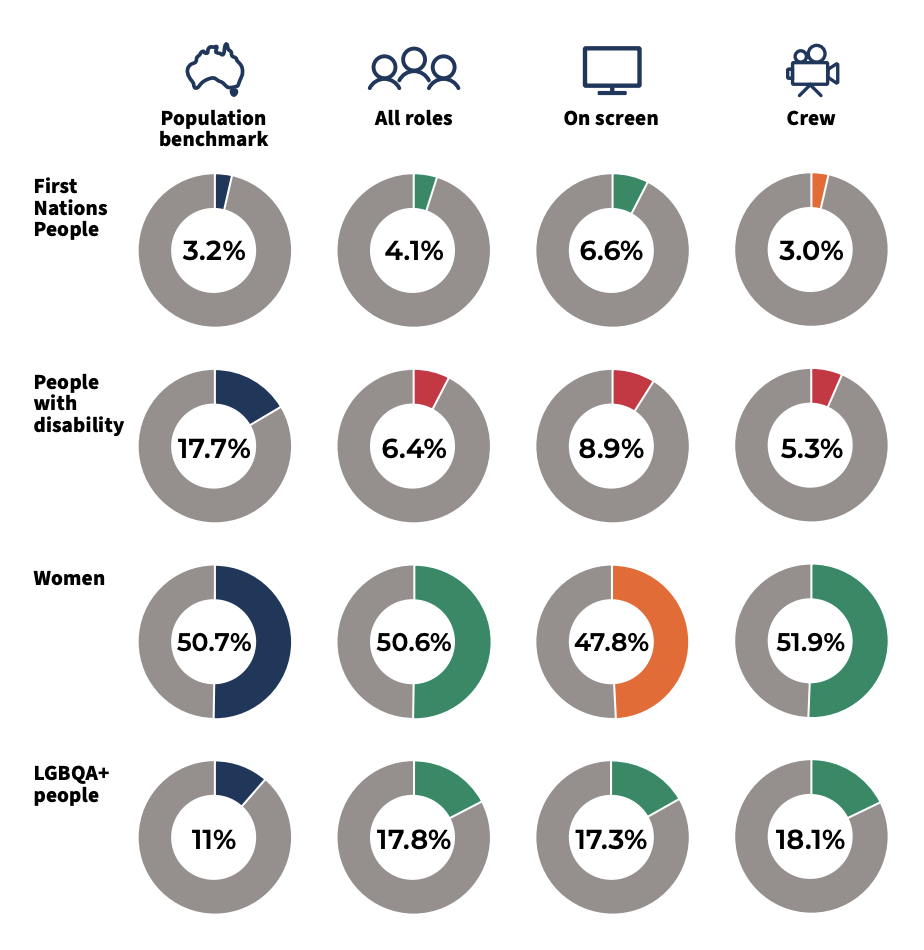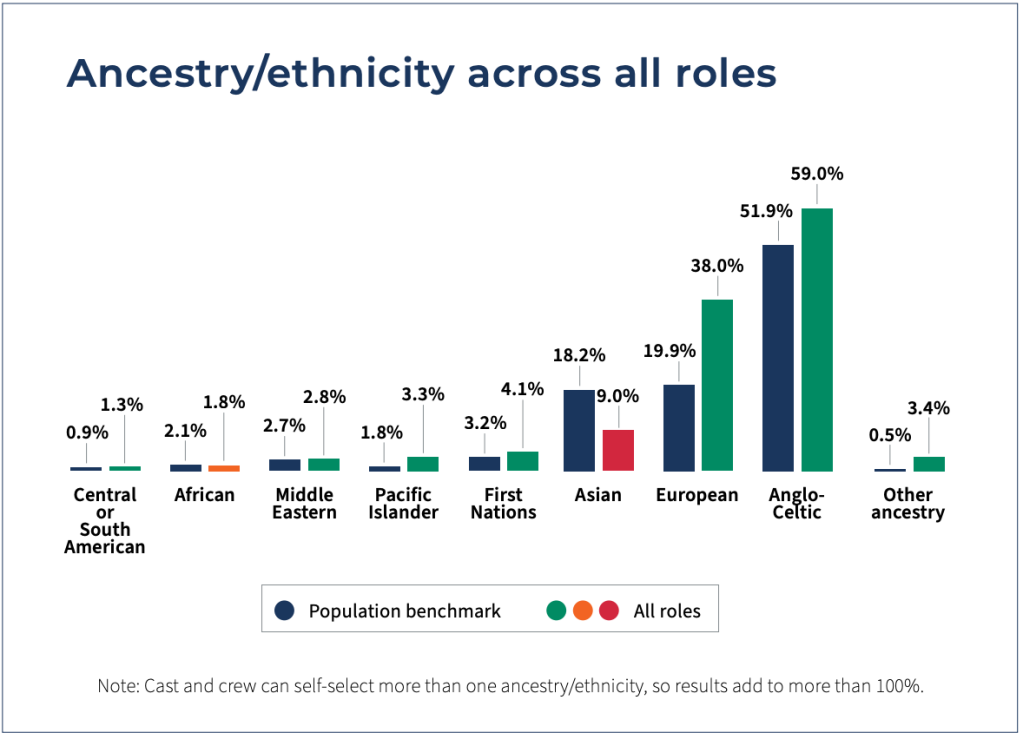The Screen Diversity and Inclusion Network (SDIN) has released the first national report into the diversity of both cast and crew working across Australia’s TV and film industry.
The report, to be released annually going forward, is based on preliminary data from online tool and voluntary demographic survey, The Everyone Project.
It considers the diversity characteristics of 944 cast and 1,967 crew across 70 registered TV and film productions completed in 2021–22, and compares them to the Census or other appropriate data.
Top line findings of the Everyone Counts report are:
- First Nations people were well-represented in on-screen roles (6.6 per cent) compared to the population benchmark (3.2 per cent), but less so among crew (3.0 per cent)
- People with disability were vastly under-represented compared to the population benchmark (17.7 per cent), both on screen (8.9 per cent) and behind the camera (5.3 per cent)
- Women’s overall representation (50.6 per cent) aligned with the population (50.7 per cent). However, the report acknowledges that other research shows that many screen industry roles remain gendered.
- LGBQA+ people were well represented compared to the population benchmark (11 per cent), both on screen (17.3 per cent) and off (18.1 per cent). Questions about sexual orientation are asked separately to questions about gender identity and intersex variations; 1.7 per cent of people identified themselves as transgender; 1.9 per cent identified themselves as non-binary/gender fluid or another gender identity, and 1.1 per cent self-selected that they were intersex and a further 1.6 per cent responded that they were unsure whether they were born with intersex variations.
- Overall, people from Asian backgrounds were under-represented (9.0 per cent), and people from European (38.0 per cent) and Anglo-Celtic backgrounds (59.0 per cent) were over-represented compared to population benchmarks (18.2 per cent, 19.9 per cent and 51.9 per cent respectively).

How the Everyone Project works is that producers register a production using the tool, and then upload its cast and crew list. Everyone working on that production is then invited to participate in a short, voluntary demographic survey. The de-identified data forms the basis of this report, and also enables organisations to internally track their diversity performance against the broader industry and Australian population.
While the SDIN hopes this data will be the beginning in identifying areas for practical change, it notes these current findings are not yet representative of the entire industry and urges caution in using them to draw conclusions or set benchmarks..
For the data quality to improve, it urges that more screen projects use The Everyone Project.
The hope is that as participation increases, the SDIN will then be able to report on intersectionality, roles with influence, and project types including format, release platform, genre and budget.
SDIN co-chair and ABC head of Indigenous Kelrick Martin tells IF there is a collective will within the network to improve representation, and he hopes the results from the Everyone Project would prove more than just a speaking point.
“We wanted to create a robust tool that would be a perpetual representation and measure for what’s going on in this country,” he said.
“While this is just the very first year and the data isn’t fully complete, it is our first step… With increased awareness and data collection over the next goodness knows how many years on an annual basis, we will have more and more detailed assessment on where things are at. The sky’s the limit from there.”
Fellow chair and SBS content industry diversity manager Michelle Cheng echoes his sentiments, arguing that the tool is for everyone to participate in, and that diversity and inclusion is not “a niche issue”. She hopes the results of this report will be the start a conversation.
“As we see more data and more participation over the years, we hope that it’ll be useful to inform policy and initiatives within our member organisations. So for argument’s sake, if over the next three years we’re seeing consistent shortages in representation of particular group, as an industry we might say let’s work together to try and raise initiatives that really address this rather than focusing our attention on areas that might not be as immediately pressing,” she tells IF.
While the representation of First Nations people is higher than the population benchmark, the Everyone Counts report acknowledges that this does not necessarily reflect strong First Nations representation across types of roles and projects.
“Reflecting previous research, it is likely that roles held by First Nations people may be concentrated in some productions, rather than dispersed throughout the industry,” it states.
Further, while it also suggests there is a shift towards gender equity, it notes that “the results may reflect a selection bias if women are more likely to respond to the survey”.
Similarly it acknowledges producers may be more motivated to encourage survey participation in The Everyone Project if a production features a diverse cast and crew; and individuals from historically excluded backgrounds may be more motivated to complete the survey than those who are not.
“These biases would mean that our data indicates more diversity in the industry than there really is. Conversely, some people from historically excluded backgrounds may be wary of participating in surveys that ask them about their background or identity,” the report states.

Of the 70 projects captured by the data, 70 per cent were drama, 14 per cent factual and documentary, 11 per cent reality and light entertainment, and 3 per cent children’s.
Some 49 per cent were made for paid on-demand platforms, 38 per cent for free-to-air and 16 per cent for theatrical.
The SDIN consists of all of the free-to-air broadcasters, Amazon Prime Video, ASTRA, Free TV Australia, Screen Australia, the state screen agencies, Screen Producers Australia, the Australian Directors’ Guild, the Casting Guild of Australia and AFTRS.
Martin notes the work of Screen Australia’s First Nations department as “an incredible strength” within Australian industry, indicating the kind of change that is possible – albeit with time.
“We see the outcomes of those initiatives and programs today, all the time in terms of content that’s coming out; amazing projects that are being made and films have been released. That’s something that took a very long time; the department’s been around for over 25 years,” he says.
“While it’s great to get the report out and it’s great to say, ‘Hey, come and join and be a part of it’ – it is a long process. But the rewards are there and we can see those rewards evident in in those initiatives through Screen Australia, through state agencies, through a variety of different broadcasters as well. It’s one of the things now I’m seeing in my role at the ABC being leveraged to apply to other diversity areas that need addressing… Hopefully we can use those learnings as well.”
As a Chinese-Malaysian-Australian who began her career as TV writer on a quiz show, Cheng urges cast and crew of diverse background to know the industry does want to make the shift.
“For people who do identify with these diverse groups; the industry really cares about representation for you. That’s a really powerful message that we want to send – that all our members do support making sure that our industry really reflect who we are as a nation.”
Read the report here.


